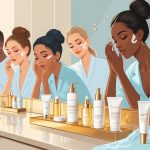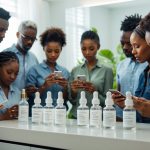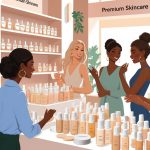Foundation Shade Swaps Makeup Artists Secretly Rely on for Natural Results
Tailoring Recommendations for Unique Skin Needs
My skin? Chaos. Post-breakout marks, random dry patches, undertones that fight every foundation range. Apps want a perfect, makeup-free selfie. Sorry, but my skin looks like two different people depending on the angle. Nobody says it, but those AI shade tools (Arbelle, “Find My Foundation Shade,” whatever) only work if you upload a clear, makeup-free photo at the exact right time of day. Who’s got time for that? Not me.
And texture—nobody talks about it. Matching a glowy foundation for oily spots is not the same as dealing with flaky, retinoid-destroyed cheeks. Pro tip I heard from a derm backstage: actually list your allergies, HIV meds, and the climate you live in when you’re asking for recs. Algorithms say “fragrance is fine” because most people don’t react, but I’ve survived NYC winters with eczema, so… no. I’m convinced the only way to get a good match is to mash up algorithm results with your own weird experiences. Siri’s not going to notice when my face turns orange after six days in Mexico.
Frequently Asked Questions
Some mornings, halfway through blending, I’m already regretting yesterday’s shade. Undertone disaster. Random splotches that show up under the world’s harshest public bathroom lights. I keep thinking I know every trick, but then some new kit drops and I’m back to square one, wishing I could text a friend for help.
How can I find the perfect foundation match for my skin tone?
Undertones are a scam. I swear, every MAC artist has made fun of my wrist veins at least once. Brands always say, “Swatch your jawline,” but sunlight exposes every lie. Anything I try under store lights turns orange or grey by the time I get home.
A dermatologist told me—no joke—72% of people use the wrong undertone. Even those digital “find your shade” tools mess up if you’ve got scars or texture, so I just stick with natural daylight, swatch on the lower cheek, and double-check, triple-check, whatever.
What are some insider tips for mixing foundations to create a custom shade?
Everyone has at least three expensive bottles in the wrong shade. Don’t ask how many I have. Sometimes I mix matte and dewy formulas for some cheekbone glow, or just dump two random brands together to avoid a last-minute drugstore run.
Backstage tip: dampen a Beautyblender, smash in a drop of face oil, and suddenly that crusty full-coverage formula is wearable. I’ve mixed Estée Lauder Double Wear with NARS Sheer Glow—sometimes it’s magic, sometimes it turns ashy and I regret everything.
Can you recommend techniques to ensure my foundation looks natural in all lighting?
Instagram selfies lie. Elevator mirrors tell the truth, and it’s always brutal. Artists say to step outside mid-application—ring lights with “daylight” settings are traitors. Hotel lighting is a nightmare. Restaurants with those red heat lamps? Forget it.
Blending down the neck is still my anxiety zone. A photographer once told me, “You missed your ear,” so now I drag a soft brush everywhere—jaw, hairline, ears, whatever. SPF 30 foundation? Flashback city. Take a test photo with and without flash before you leave, or just accept your fate.
What are the top products that makeup artists use for seamless shade matching?
Everyone says Fenty Pro Filt’r, but honestly, RCMA foundation palette is my holy grail—the adjuster shades are tiny miracles. MAC Face and Body is my go-to for sheerness; it never pills under sunscreen. Maybelline Fit Me is my drugstore backup, no shame.
I’ve watched artists mix Make Up For Ever Ultra HD with random drops, or toss in a pump of L.A. Girl Pro Coverage white when things get too dark. Never seen anyone actually finish those custom drops before they expire, though. Are they a scam? Maybe. Still, they’re fun to play with.
How do I adjust my foundation shade for seasonal skin tone changes?
Sun happens. Last August I matched my chest, not my jaw, and looked jaundiced for a week. In winter I use Cover FX Custom Cover Drops to darken things up. Spring hits, I mix in tinted moisturizer or bronzer and just hope for the best.
Friends swear self-tanner fixes everything, but for me it just highlights every dry patch. Experts say to buy two shades and mix as you go, but honestly, who has the budget? The bottles multiply anyway. I give up.
What’s the best way to test if a foundation shade works for my skin without applying it all over my face?
Testing on my wrist? Nope, not falling for that again. I swipe a stripe from cheek to neck—right there, super obvious—and then I just… wait. Like, 15 minutes, minimum. Because somehow every “perfect” shade morphs into this weird orange mess once it’s had time to settle. Honestly, I’ve started carrying a tiny mirror around just so I can check in real sunlight or, I don’t know, the backseat of my car. Store mirrors? Total scam. Who designs those lights? Not anyone who actually wears makeup, that’s for sure.
And then there’s the “just leave it on while you shop” move. I do that. I’ll run errands with a streak on my jaw, pretending I’m not self-conscious, and by the time I get home, the foundation’s either creased, vanished, or made me look like I have a weird rash. Especially on my chin—why does it always disappear there? I talk, I touch my face, and poof, it’s gone. You’d think brands would have figured this out by now, but nope. Still a mess.



